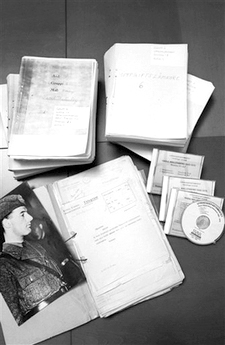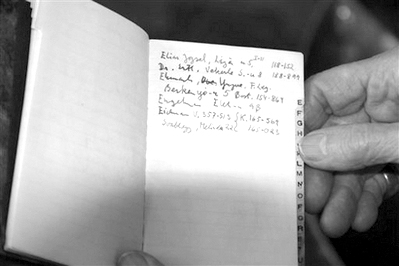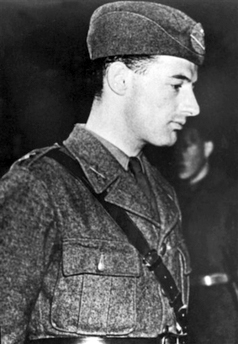One man can make a difference
The mystery of Raoul Wallenberg remains unsolved. Sixty-eight years after Swedish diplomat Raoul Wallenberg was arrested in Budapest by agents of Russian counterespionage organization Smersh, his fate remains one of the most troubling enigmas of the Second World War.
-
 Sweden on April 27, 2008, released 1,200 previously classified documents and three compact discs containing some 28,000 documents on Raoul Wallenberg, who is credited with saving tens of thousands of Hungarian Jews from the Nazis during World War II.
Sweden on April 27, 2008, released 1,200 previously classified documents and three compact discs containing some 28,000 documents on Raoul Wallenberg, who is credited with saving tens of thousands of Hungarian Jews from the Nazis during World War II. -
-
The official Raoul Wallenberg exhibition, "To me there's no other choice—Raoul Wallenberg 1912-2012," organized by the Swedish Institute and supported by the Swedish government, opens in Budapest on Jan. 17 and will later travel to the U.S., opening in New York in March. See The Swedish Foreign Ministry calendar of events for updates on events and activities.
Watch the official video presentation here: Raoul Wallenberg, the Exhibition -
 A telephone diary of Raoul Wallenberg, the Swedish diplomat credited with saving tens of thousands of Hungarian Jews from the Holocaust, contains the contact number in Budapest for Adolf Eichmann, the Nazi officer directing deportations to the Auschwitz death camp.
A telephone diary of Raoul Wallenberg, the Swedish diplomat credited with saving tens of thousands of Hungarian Jews from the Holocaust, contains the contact number in Budapest for Adolf Eichmann, the Nazi officer directing deportations to the Auschwitz death camp. -
-
New facts surrounding the death of Raoul Wallenberg emerged in late 2011, and these may change earlier stories. Historians have revealed that the Swedish diplomat, who was known for his heroic efforts in Budapest in 1944-1945 when he rescued a large number of Jews from deportation, was most likely “prisoner nr 7.” Susanne Berger and Vadim Birstein, two respected researchers in the Wallenberg case, have received new information from Russian authorities, information that implies Wallenberg could have been alive after July 17.
The Russian security service FSB has stated in a letter that a "prisoner nr 7" was questioned on July 23 in 1947 and that he "most likely" was Raoul Wallenberg. The new material states the following: The Lubjanka prison in Moscow, July 23, 1947. According to the official version, six days have passed since Wallenberg died. A guard notes in the prison register that S Kartasjov from the security service is questioning the prisoner Vilmos Langfelder and his cellmate Sandor Katona during 16 hours. During the interrogation from two in the morning until the following evening, Kartasjov questions also a "prisoner nr 7." At different moments between six and seven p.m., the three prisoners are brought through the guardroom again.
Says Berger: “This is sensational! This is the first time Russian authorities admit that Raoul Wallenberg may have been alive after July 17 in 1947.” The old version, the so-called Gromyko’s memorandum, stated that Wallenberg was executed in the Lubjanka prison on July 17 in 1947. Berger adds, “The new information would mean that Gromyko's memorandum is obsolete. The Russian authorities have this time shown a new openness and if the new information is confirmed, it is the most spectacular information from Russia in the last fifty years.” -
 An undated photo of Raoul Wallenberg.
An undated photo of Raoul Wallenberg. -
Wallenberg led heroic efforts to prevent the deportation of Jews from Hungary to Nazi concentration camps during the closing months of the war, saving the lives of tens of thousands of people.
On January 12, 2001, a joint Swedish-Russian Committee announced their findings following nine years of research into the mystery of the missing diplomat. The result: The Russians claim that Wallenberg died, presumably by execution, on July, 17, 1947, in the notorious Lubyanka Prison. In the absence of a death certificate or other conclusive proof, however, the Swedish government holds open the possibility that Wallenberg survived.
Despite the passage of so many years, there are still huge gaps in the record of the final years of this unusual man. Exactly why Wallenberg was arrested remains unknown, although it is known he was suspected of being a spy for Germany or the United States.
Of course, Wallenberg was just one of millions of people who tragically disappeared into the Soviet prison system or gulag, but he was unique in several ways: He was a diplomat of a neutral country and a member of one of Europe’s most influential families. Most importantly, he has come to symbolize to post-war generations the possibility of one man standing up to defy the machinery of Nazi genocide.
Wallenberg had bribed and lied to Gestapo and Black Arrow officials in Budapest during the closing months of the war in order prevent deportations, and provided Jews with more than 15,000 bogus Swedish passports and certificates that he designed himself. He regularly visited train stations to distribute the passes to Hungarian Jews, pulling people off trains bound for Auschwitz, Birkenau and other death camps. He also obtained large amounts of food and medical supplies and purchased approximately 30 apartment buildings, which were designated as Swedish safe-houses and used to house thousands of Jews threatened with deportation.
Wallenberg was arrested in Budapest soon after the Soviet army entered in January 1945. He was taken by train to Moscow, where he immediately vanished into the Russian prison system. For the next ten years, the Soviets denied all knowledge of his whereabouts, and even denied he was in their country.
There is a still a chance that some of the key questions regarding the fate of Wallenberg will be answered, despite repeated assurances by various government officials that the paper trail has been followed as far as it can go.
“It is necessary to try to find new facts shedding light on the fate of Wallenberg,” former PM Persson and other leading Swedish politicians have said. “Future research must assume that Raoul Wallenberg could have been alive after 1947.” -
-
